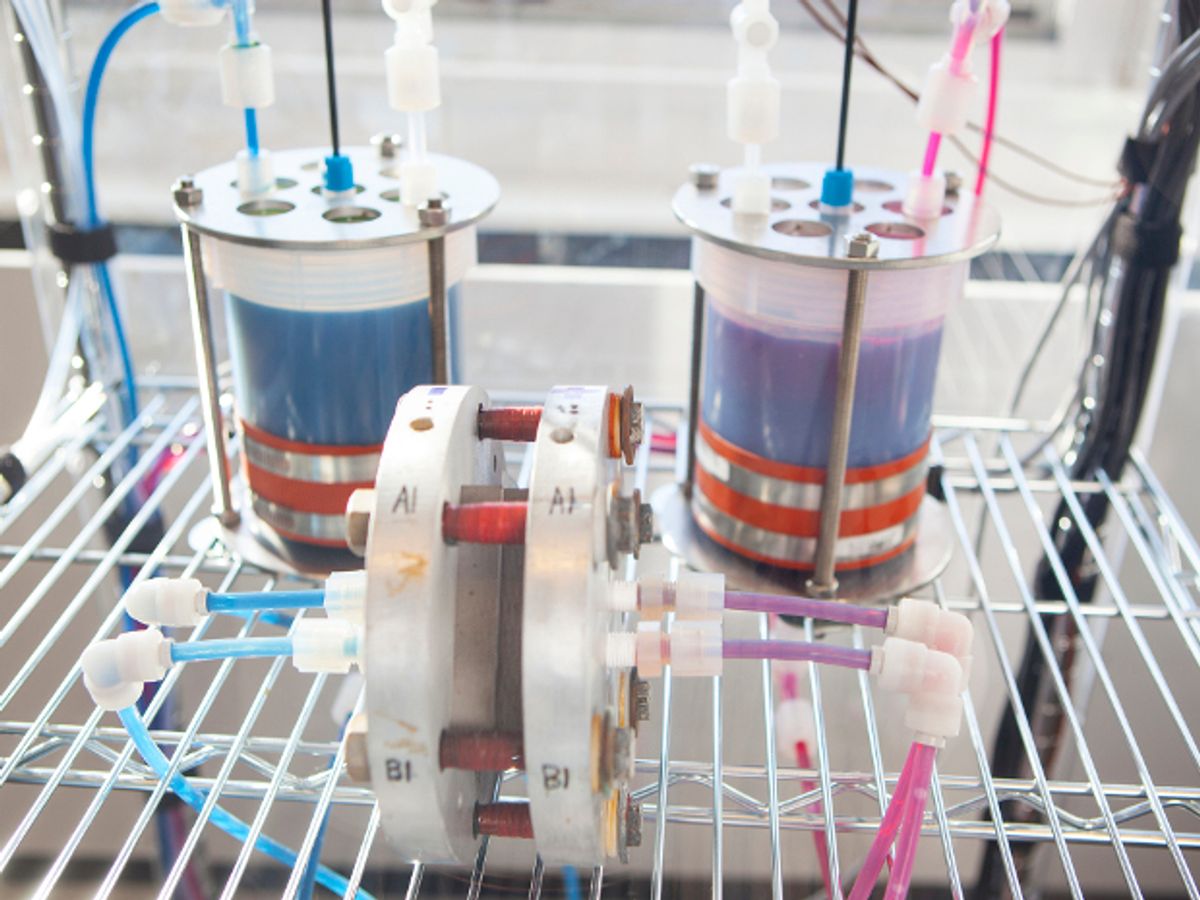Rhubarb battery, anyone?
A group at Harvard University has created an aqueous flow battery that uses a quinone, a type of organic molecule that happens to have favorable electrochemical properties. The particular quinone they used is nearly identical to one found in rhubarb.
Flow batteries, which date back more than three decades, replace the solid electrodes of standard batteries with two liquid electrolytes. The liquids, contained in separated tanks, flow through a cell stack, letting ions and electrons move through a porous membrane in order to discharge and recharge the battery. They are considered good candidates for large-scale renewable energy storage because you can scale up the tank size of a flow battery in order to increase the megawatt-hours of storage available without being forced to also scale up the power capacity; with more traditional batteries like lithium-ion, the components come as a package deal, meaning to achieve 50 megawatt-hours of energy storage you also need to pay for 50 megawatts capacity.
That said, flow batteries haven't yet taken the world by storm. The problem, generally, is cost. The most commercially advanced flow battery uses vanadium, an expensive metal; the team at Harvard, led by senior author Michael Aziz, eliminated metals entirely from their version of a flow battery.
“The whole world of electricity storage has been using metal ions in various charge states but there is a limited number that you can put into solution and use to store energy, and none of them can economically store massive amounts of renewable energy,” said another study author, Roy Gordon, also of Harvard, in a press release. “With organic molecules, we introduce a vast new set of possibilities. Some of them will be terrible and some will be really good. With these quinones we have the first ones that look really good.”
The team used a quinone known as 9,10-anthraquinone-2,7-disulfonic acid, or AQDS. According to their paper, to be published tomorrow in Nature, "AQDS undergoes extremely rapid and reversible two-electron two-proton reduction on a glassy carbon electrode in sulfuric acid." Using cheap carbon electrodes, they created a flow battery that essentially matches the performance of existing vanadium flow batteries.
The battery has also run through a hundred or so cycles so far, and the researchers acknowledge that much more testing and tweaking is still required to optimize their design. But in those few cycles, they saw essentially no losses: the galvanic discharge capacity retention, measured as the number of coulombs extracted in one cycle divided by that number in the previous cycle, is above 99 percent. The prototype they made is quite small, but the authors imagine more practically sized versions; a battery with a tank the size of a home heating oil tank, for example, could store a day's worth of solar-generated power and keep a house running through the night. A partnership with fuel cell manufacturer Sustainable Innovations aims at a battery "the size of a horse trailer" within three years, capable of connecting to solar arrays on large commercial buildings, for example.
“I think the chemistry we have right now might be the best that’s out there for stationary storage and quite possibly cheap enough to make it in the marketplace,” Aziz said. “But we have ideas that could lead to huge improvements.”
The group was partially funded by the Advanced Research Projects Agency—Energy (ARPA-E), and the ARPA-E program director praised the result. As we've written here, ARPA-E has focused sharply on energy storage tech, and that seems to yielding some truly promising results. The rhubarb-flow battery—a name I strongly encourage the creators to adopt—is still likely years from commercialization, and of course any number of "breakthrough" technologies don't end up breaking through much of anything, but novel approaches rather than incremental improvements are desperately needed in order to continue the rapid scale-up of renewable energy.
Photo credit: Eliza Grinnell, Harvard School of Engineering and Applied Sciences
Dave Levitan is the science writer for FactCheck.org, where he investigates the false and misleading claims about science that U.S. politicians occasionally make.



